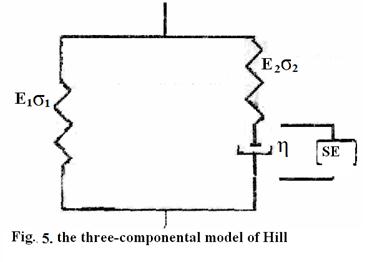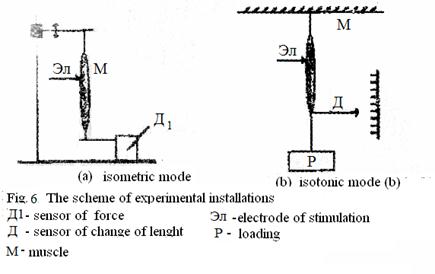 |
АвтоАвтоматизацияАрхитектураАстрономияАудитБиологияБухгалтерияВоенное делоГенетикаГеографияГеологияГосударствоДомДругоеЖурналистика и СМИИзобретательствоИностранные языкиИнформатикаИскусствоИсторияКомпьютерыКулинарияКультураЛексикологияЛитератураЛогикаМаркетингМатематикаМашиностроениеМедицинаМенеджментМеталлы и СваркаМеханикаМузыкаНаселениеОбразованиеОхрана безопасности жизниОхрана ТрудаПедагогикаПолитикаПравоПриборостроениеПрограммированиеПроизводствоПромышленностьПсихологияРадиоРегилияСвязьСоциологияСпортСтандартизацияСтроительствоТехнологииТорговляТуризмФизикаФизиологияФилософияФинансыХимияХозяйствоЦеннообразованиеЧерчениеЭкологияЭконометрикаЭкономикаЭлектроникаЮриспунденкция
Biomechanics of a muscle
|
Читайте также: |
Muscles can be presented as the continuous environment, consisting of the big number of the elements which are cooperating among themselves without impacts and being a floor of external forces. The muscle simultaneously possesses property of elasticity and viscosity, that is is the is viscous-elastic environment. For such environment laws of classical mechanics are used.
Fundamental concepts of mechanics of continuous environments are deformation, a pressure, elasticity, viscosity, and also energy and temperature.
Elasticity - property of bodies to change the sizes and the form under action of forces and spontaneously to restore them at the termination of external influences.
Elasticity of bodies is caused by forces of interaction of its atoms and molecules. At removal of external influence the body spontaneously comes back in an initial condition.
Viscosity - internally friction of environment.
Viscoelasticity - is a property of materials of firm bodies to combine elasticity and viscosity.
Deformation - relative change of length 
l -initial length,  Value of lengthening,
Value of lengthening,  can change a sign
can change a sign
Pressure mechanical  -measure of the internal forces arising at deformation of a material.
-measure of the internal forces arising at deformation of a material.
For a homogeneous core  , where S - the area of section, F - force, operating on a core Elastic deformation arises and disappears simultaneously with loading and is not accompanied by dispersion of energy. For elastic deformation Hooke's law is fair
, where S - the area of section, F - force, operating on a core Elastic deformation arises and disappears simultaneously with loading and is not accompanied by dispersion of energy. For elastic deformation Hooke's law is fair
 , where Е - module Junga defined by the nature of substance. At small stretchings consider Е=const.
, where Е - module Junga defined by the nature of substance. At small stretchings consider Е=const.
Elastin - elastic fiber of vertebrate animals is in walls of arteries. Collagen - fibrous fiber.
20 % of all fibers of muscles - collagen, it is also in sinews, cartilages, a bone.
In case of the viscous environment a pressure  is defined by speed of deformation d
is defined by speed of deformation d  /dt
/dt
 ,
,  - factor of viscosity of environment
- factor of viscosity of environment
Passive mechanical properties of the viscoelastic environment can be modelled a combination of elastic and viscous elements. The muscle is not neither cleanly elastic, nor cleanly viscous element. A muscle - a viscoelastic element.
Passive stretching. On the basis of settlement and experimental data good is shown, that the three-componental model of Hill is most the simple model, which gives the greatest approach mechanical properties of muscles.

Let's admit, that element Е2, no ( ). Then for the viscoelastic environment a pressure in system
). Then for the viscoelastic environment a pressure in system

 +
+  ,
, 
Let's find dependence  (t). At the initial moment of time t = 0 deformation
(t). At the initial moment of time t = 0 deformation  = 0.
= 0.
In result we shall receive 
where size  is called time of delay.
is called time of delay.
Speed of increase of deformation is maximal at t = 0

Deformation  (t)
(t)
grows with decreasing speed and comes nearer to stationary value 

Parallel elastic element Е1 defines mechanical properties of external membranes of cells (sarcolemma) and internal structures - T-systems and sarcoplasmic reticulum.
Consecutive element Е2 defines elasticity of actin-myosin complex, caused, a point of an attachment of actin to Z-disks and junctions of bridges with the active centers of thin strings.
The viscous element  is caused by sliding of strings actin rather of myosin. This of a component sharply increases at a passive mode of a muscle, т. To. In this case bridges are opened. It is shown in an opportunity of a strong stretching of a passive muscle even at insignificant loadings.
is caused by sliding of strings actin rather of myosin. This of a component sharply increases at a passive mode of a muscle, т. To. In this case bridges are opened. It is shown in an opportunity of a strong stretching of a passive muscle even at insignificant loadings.
Active reduction of a muscle.
For research of characteristics of reduced muscles use two artificial modes:
1. Isometric mode at which the length of a muscle l = const, and is registered developed force F (t).
2.  Isotonic mode at which the muscle lifts constant cargo Р = const, and is registered change of its length in time
Isotonic mode at which the muscle lifts constant cargo Р = const, and is registered change of its length in time  .
.
At an isometric mode by means of a clamp (fig. 6.) preliminary establish length of a muscle l.
. After installation of length on electrodes the electric stimulus moves, and by means of the gauge function F (t) is registered. The kind of function F (t) in an isometric mode for two various lengths is presented on fig. 7, and.
Maximal force Р which the muscle can develop, depends on its initial length and area of overlapping of actin and myosin strings in which bridges can become isolated: at initial length of sarcomere 2,2 microns in reduction participate all bridges (see fig. 4).
 Therefore the maximal force is generated when the muscle is preliminary stretched on installation (fig. 6) so its lengths sarcomere were close to 2,2 microns. On fig. 7, and it corresponds to initial lengths of two muscles
Therefore the maximal force is generated when the muscle is preliminary stretched on installation (fig. 6) so its lengths sarcomere were close to 2,2 microns. On fig. 7, and it corresponds to initial lengths of two muscles 
At isotonic mode by the loose end of muscle suspend cargo Р (fig.6). After that the stimulus moves and change of length of a muscle in time is registered: 
The kind of this function in isotonic mode for two different loadings is shown on fig. 7.b.
Поиск по сайту: